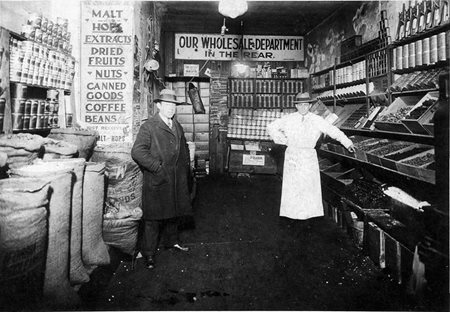Nuts.com Transitions into Headless Commerce
In 1929, a father and a working-class man with little more than inspiration, fortitude—and his best suit—walked into a bank and asked for a business loan to open a shop. His timing happened to occur on the threshold of what would be one of the most devastating economic periods in history. He called his store the Newark Nut Company, and he became known for selling the finest, top-quality nuts and dried fruit. As his reputation grew, so did his trade, and through two inevitable factors of life—time and change—his company endured. The Newark Nut Company has rebranded and modernized into a virtual retail entity that remains a thriving, family-represented enterprise headquartered in Jersey City, NJ, with operations in Cranford, NJ, as well as a popular kiosk in Newark's Penn Station less than a mile from where it all began 90-years earlier.
with little more than inspiration, fortitude—and his best suit—walked into a bank and asked for a business loan to open a shop. His timing happened to occur on the threshold of what would be one of the most devastating economic periods in history. He called his store the Newark Nut Company, and he became known for selling the finest, top-quality nuts and dried fruit. As his reputation grew, so did his trade, and through two inevitable factors of life—time and change—his company endured. The Newark Nut Company has rebranded and modernized into a virtual retail entity that remains a thriving, family-represented enterprise headquartered in Jersey City, NJ, with operations in Cranford, NJ, as well as a popular kiosk in Newark's Penn Station less than a mile from where it all began 90-years earlier.
In keeping pace with business evolution, the Newark Nut Company launched their first cyber-retail offerings in 1999 as ‘NutsOnline’. In 2012, that became abbreviated to what is now known as Nuts.com—catering to a world-market hungry for their 4000 delectable temptations. Well-beyond a simple purveyor of nuts and dried-fruit, Nuts.com’s diverse product catalog includes chocolate, candy, vitamins, super-food powders, coffee, and tea. Their fares are available in organic or gluten-free and sold in order sizes of one pound to one-thousand pounds. From the humble beginnings of a family man with an idea and gumption to a company with annual revenues that surpassed $50 million in 2018, Nuts.com certainly embodies the story of the ‘American Dream’.
To stay competitive in today’s online space and support forecasted business growth, Nuts.com decided it was time to do away with their monolithic commerce platform and adopt a more resilient platform that would link their B2C, B2B, and wholesale divisions to accommodate them for years to come. Nuts.com was looking for flexibility and adaptability to meet the modern customer’s consumption demands that transcend the classical webpage to incorporate mobile apps and other similar platforms.

According to Alex Shiferman, Chief Technology Officer at Nuts.com, when the online retailer committed to their digital revamp, they chose to go with a headless approach as a way to future-proof their platform. In a press release, Alex stated, “We pride ourselves on the quality of our products and the excellent customer service we deliver. To continue serving our customers and accommodating the growth we anticipate, we needed a commerce technology platform with agility, resiliency, and future-proofing. Moving to the commercetools commerce platform gives our technology, merchandising, and marketing teams the foundation they need to continue to grow our business.”
Transitioning Into the Future
One of the biggest challenges Nuts.com has to face during their transition is the transition itself. The website is their business, so ensuring that everything continues to run smoothly on the front end and business could carry on per usual was mission-critical. In CMSC Media’s exclusive interview with Alex, he shared that the strategy they are taking is to move the website over to the new platform piece by piece. They recognize that though the operation is going to take longer, it will result in an overall safer and more secure execution. For the type of significant systems rebuild the project presents, Nuts.com chose to place their confidence with commercetools to allay their concerns and provide that seamless transition.
“We are pure digital player, so for us, Nuts.com is our business, so we are very, very sensitive to potential risks of big-bang launches,” Alex told us. “Replatforming is a major effort for us in 2019 and 2020, and we're right the middle of this migration. And the way we're approaching this is we're transitioning from old platform to the new one one front-end module at a time, so it’s very seamless to the user. On any given page, one module could be served out of our old platform, and another module could be served out of commercetools. Our goal is to complete this incremental transition over the next year”
Alex mentioned one of the reasons Nuts.com trusted commercetools with the complex changeover was due to its expertise that not only matched their immediate requirements but could also adapt to the retailer’s buildout needs.
“We really felt that with commercetools, [the] things they did, they did really well. We felt that it was a very polished, very mature product. And it addressed our most immediate needs. Other products we looked at had different feature sets, different maturity levels, but this was the right fit for us in terms of both short-term and long-term needs and product features, and also just how stable, how mature the product was. We are also big believers in the microservices. The goal is, as we start using the commercetools, to also build custom home-grown microservices that could stand along commercetools. So, they aligned well with our general philosophy of how we want to build our product and how we want to build our business.”
In the commercetools sponsored webinar, 'Who’s Minding the Digital Store?', Alex addresses that fact that choosing a strategy was a team effort, and he made sure that every department was part of the decision making process. It was important to meet not only the customers’ needs, but also ensure he met the Nuts.com IT and service employee teams’ needs as well.
Technology trends, architecture, and flexibility were one of the main reasons that Nuts.com chose to go with a headless solution. During our conversation, Alex also shared that,"the reason we chose headless as an approach is because as we transition from a home-grown platform that is close to 20 years old we want to move to a platform that will not only enable faster development and support the current business and its needs, but also support future known and unknown needs. Where do we want to go in two years, in five years and beyond? So, one thing we're looking for is maximum flexibility and adaptability in order to support customer expectations that are always changing, from webpages to single-page apps, to progressive web apps, [mobile apps], and beyond. We don't want to be restricted by the constraints of the older school e-Com platforms we somewhat pre-defined front-end experience. Headless setup provides us with maximum flexibility, and we are basically now transitioning our website to—as step one— a single page app powered by commercetools’ APIs [Application Programming Interface]. Our future plans include PWAs [Progressive Web Apps] and mobile apps, and that is something that would take a significant effort an older school monolithic platforms. For us, the decision was not just how to address immediate business needs for the next year, but how to address needs for the next five or ten years so that we never have to re-platform again."
Going Headless – A Must for Business
As one of the pioneers of headless commerce,  commercetools has unparalleled expertise in helping businesses like Nuts.com with their digital transformation. In an exclusive interview, Kelly Goetsch, Chief Product Officer at commercetools shared with CMSC Media, “We [commercetools] were the ones who invented headless commerce, and we came up to market with it first in 2013…we really invented that space…We’ve never had a ‘head’ to our platform and we never will. It’s not part of our business. We believe that customers should be able to build their own front ends as they please and have that full freedom and flexibility…some of our customers build some things from scratch, some of them buy. We're pretty open about that, and it's really great. We're also, actually, native cloud, so we're not just armed virtual machines in the cloud as some of our more legacy competitors do. We're actually part of the cloud ecosystem, and a talk I give a lot is if Google, Microsoft, or Amazon built a commerce platform, what would it look like? And it would look remarkably similar to what we've built, so we actually work with eventing which is native in the cloud, we work with functions in the service, which is a really big part of the cloud. We're really part of that whole ecosystem; we're not just sitting there in a virtual recede in a little walled garden in the pond.”
commercetools has unparalleled expertise in helping businesses like Nuts.com with their digital transformation. In an exclusive interview, Kelly Goetsch, Chief Product Officer at commercetools shared with CMSC Media, “We [commercetools] were the ones who invented headless commerce, and we came up to market with it first in 2013…we really invented that space…We’ve never had a ‘head’ to our platform and we never will. It’s not part of our business. We believe that customers should be able to build their own front ends as they please and have that full freedom and flexibility…some of our customers build some things from scratch, some of them buy. We're pretty open about that, and it's really great. We're also, actually, native cloud, so we're not just armed virtual machines in the cloud as some of our more legacy competitors do. We're actually part of the cloud ecosystem, and a talk I give a lot is if Google, Microsoft, or Amazon built a commerce platform, what would it look like? And it would look remarkably similar to what we've built, so we actually work with eventing which is native in the cloud, we work with functions in the service, which is a really big part of the cloud. We're really part of that whole ecosystem; we're not just sitting there in a virtual recede in a little walled garden in the pond.”
“We're also multi-tenant, meaning we have one copy of our platform running that serves all of our customers. And we're multi-tenant in the same way that Gmail is multi-tenant, or AWX is multi-tenant. We're all public—all public use public services are all multi-tenant. Our legacy platforms are (the ones that we compete against) they're all very single-tenant. I think those are some of our core differentiators, and then we're also doing a lot of machinery learning-based product innovation.”
Kelly also told us that commercetools is ‘all-in’ on GraphQL—which Alex Shiferman confirmed Nuts.com is also implementing—and on which he is writing a book about. When asked to tell us a little more about GraphQL, Kelly said,
“It’s a compliment to REST APIs. So, with Direct API [Application Programming Interface], headless is great, but if you're a client developer—if you're building a webpage, a product detail page—let's just say, for example, you have to call the product API. You have to call the inventory API; you have to call the category API, you have to call these different APIs. And when you call the APIs, you have to specify what data you want; otherwise, you'll get the entire product record, the entire category record, and that can be a lot. But with GraphQL, what's exciting about it is you can, as a developer, specify, ‘I would like the product description’, ‘I would like the product price’, ‘I would like the name’. You know? ‘I would like all of that stuff’. And then GraphQL will call the individual APIs and build a single response back, having exactly what you wanted as a developer. And Facebook has used this, so every time you pull up Facebook or Twitter—they've used GraphQL for a couple of years now, they've been very happy with it. And Shopify now uses GraphQL, Magenta just added a little support, but we were the first to market with GraphQL. We're the big sponsors of GraphQL as a foundation. We hosted the GraphQL working last year; we have some pretty well-known developers in the GraphQL community who work for us. It's pretty exciting. It's a big deal for us, and that's why I'm spending the time to write this book on GraphQL and eCommerce.”
Out With the Old, In With the New
Leaving behind the monolithic structure and switching to a headless platform can have many direct benefits to your business. You get the freedom to customize and personalize your platform—including the front end—allowing you to have a hand in the UX. You gain speed and agility, due to its decoupled nature, and scaling and introduction of new touchpoints don’t have to be laborious or costly. Headless commerce simplifies eCommerce and ensures your brand is ready for growth, expansion, and whatever else might be coming your way in the future. For any brand doing business online, going headless is a no-brainer.
You get the freedom to customize and personalize your platform—including the front end—allowing you to have a hand in the UX. You gain speed and agility, due to its decoupled nature, and scaling and introduction of new touchpoints don’t have to be laborious or costly. Headless commerce simplifies eCommerce and ensures your brand is ready for growth, expansion, and whatever else might be coming your way in the future. For any brand doing business online, going headless is a no-brainer.

Ellie Somfelean
Ellie is a Reporter and Content Marketer with CMSC Media. She is passionate about social media and digital marketing. She has a vast experience with content creation, influencer marketing and brand promotion.